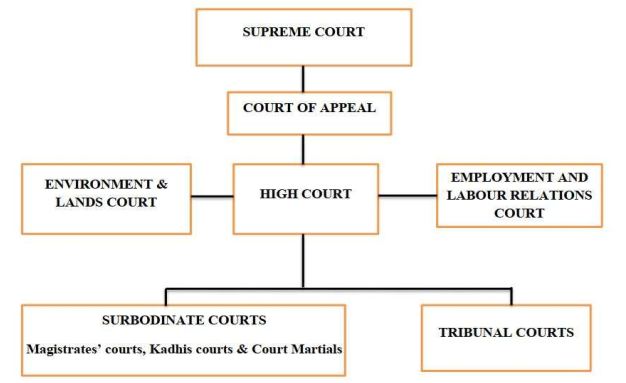Structure of courts in Kenya
The courts under the Constitution operate at two levels, namely; Superior and Subordinate courts.

The courts under the Constitution operate at two levels, namely; Superior and Subordinate courts.
Superior Courts
- Supreme court,
- Court of appeal,
- High court,
- Employment and labor relations court
- Environment and land court
Subordinate Courts:
- Magistrates’ courts
- Kadhis courts
- Court martial, and
- Any other court or local tribunal established by an act of parliament
SUPREME COURT
Composition of Supreme Court in Kenya
The Supreme Court of Kenya is the highest court in the land and the final arbiter of legal disputes. Here’s a breakdown of its composition:
Number of Judges: The Supreme Court is made up of seven (7) judges:
- Chief Justice: Presides over the Court.
- Deputy Chief Justice: Acts as the vice-president of the Court.
- Five other Justices: Complete the panel of judges.
Selection and Appointment:
- The Chief Justice and Deputy Chief Justice are nominated by the President and approved by the National Assembly.
- The other five judges are appointed by a competitive process overseen by the Judicial Service Commission, a body responsible for recruiting and disciplining judges in Kenya.
Qualifications: To be appointed a judge of the Supreme Court, an individual must be a qualified lawyer with at least fifteen (15) years of experience.
COURT OF APPEAL
Jurisdiction: It has limited original jurisdiction.
The court has powers to:
- Determine a case finally.
- Order for a trial.
- Order for a re-trial.
- Frame issues for the determination of the High Court.
- Receive additional evidence or order that it be taken by another court.
Composition: The Court of Appeal consists of a number of judges, being not fewer than 12 (twelve) and a maximum of 30 Judges, as may be prescribed by an Act of Parliament and the Court is to be organized and administered in the manner prescribed by an Act of Parliament. The Court comprises of a President of the Court of Appeal who is elected by the judges of the Court of Appeal from among themselves.
THE HIGH COURT
The High Court has jurisdiction to hear all criminal and civil cases as well as appeals from the lower courts. The High Court comprises a maximum of 200 judges and has original jurisdiction in all criminal and civil matters. The High Court is a premier court in interpreting the Constitution, hears appeals from subordinate courts and tribunals and supervises all administrative bodies (judicial review).
EMPLOYMENT AND LABOUR RELATIONS COURT AND THE LAND AND ENVIRONMENT
Court: The Constitution has also established the Employment and Labour Relations Court and the Land and Environment Court at the same level as the High Court. Employment and Labour Relations Court deals with labour and employment matters while the Land and Environment Court deals with land and environment matters and appeals from all tribunals dealing in land and environment matters.
MAGISTRATES’ COURTS
Magistrates’ Courts deals with the majority of cases in Kenya. There are 127 court stations manned by at least 542 magistrates. A Magistrate’s Court has the authority to hear all criminal cases except murder, treason and crimes under international criminal law. Magistrates’ courts also hear all civil cases except those limited by statute. Other lower courts include, Kadhis courts, Courts martial and Tribunals.
KADHIS COURTS
Establishment: It is established by the Constitution and the Kadhis Court Act as a court subordinate to the High Court.
Jurisdiction: The court is duly constituted when held by the chief Kadhi or Kadhi. It exercises original jurisdiction in civil cases only. Under the constitution, its jurisdiction is limited to the determination of questions of Muslim law relating to marriage, divorce or personal status or succession in proceeding in which all parties profess Muslim faith.
- However, the court has no exclusive jurisdiction hear such cases. The Highcourt, Resident Magistrates court and the District Magistrates court have jurisdiction to hear and determine such matters.
- The evidence applicable is governed by Islamic law of evidence. All witnesses must be heard without discrimination.
- A decision of the court may be appealed against in the High court.
THE COURTS MARTIAL
Establishment: It is established by section 85(1) of the Armed Forces Act as a Sub-ordinate court.
Composition: The court is presided over by an officer who sits with not less than 2 other persons or not less than four if an officer is being tried or where the maximum penalty for the offence is death. The court is assisted by a judge/advocate who advice on questions of procedure.
Jurisdiction: The court exercises original jurisdiction in criminal cases relating to offence committed by the members of the armed forces within the jurisdiction of the court, for example, mutiny, disobeying lawful orders or desertion.
The court has jurisdiction to impose the following sentences:
- Imprisonment
- Fine
- Dismissal from the armed forces
- Reprimand
- Reduction of rank.
A decision of the court may be appealed against in the High Court. The convict may be appealing against conviction or sentence or both.
TRIBUNALS
Tribunals are bodies established by Acts of Parliament to exercise judicial or quasi-judicial functions. They supplement ordinary courts in the administration of justice. Tribunals, however, do not have penal jurisdiction.
